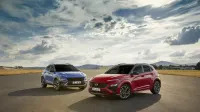Hyundai Kona and Kona N Line facelift debuts, looking sharper all around

Over 2018 and 2019, European buyers took home more than 170,000 Hyundai Konas, beating the U.S. by more than 50,000 units over the same time, and the gap has only grown wider. That’s partly why the South Korean maker has launched the facelifted Kona and all-new Kona N on the other side of the Atlantic. The standard Kona wears revised bodywork front and back that renders a sharper, sportier look. As we saw in the recent teaser shots, the sleeker front end sports a wider, narrower grille, a new design for the DRLs, a contrasting design in the lower bumper meant to mimic a skid plate, and vents at the edges of the full-width bumper. The stretched bumper also flows seamlessly into the black cladding over the wheel arches. Out back, the taillights show new graphics, a new bumper design mimics the front to stretch around the car and into the rear wheel arches, and there’s a stronger skid-plate-looking design as well.
On the all-new N Line, three slots sit above an upper and lower grille filled with a different mesh design than on the standard Kona, and a solid graphic under the main beams imitates the look of side intakes. No imitation skid plates here, but instead, an N-style lower lip in the body-colored bumper that leads to vertical fins at the corners. This model gets body-colored cladding and new rocker panels along the sides, along with 18-inch wheels. In back, a contrasting diffuser fills the body-colored bumper, with a cutout to reveal two exhaust pipes.
The new car is 40 millimeters (1.6 inches) longer, and some of that translates into more room for back-seat passengers. Wheel choices will be carryover 16-inchers plus 17- and 18-inch rims. Five new colors join the exterior palette: Cyber Gray, Dive in Jeju, Ignite Flame, Misty Jungle, and Surfy Blue.
Numerous new measures raise the interior quality. A 10.25-inch digital dash cluster is joined by a standard display audio screen that’s an inch larger, now eight inches, or an optional 10.25-inch infotainment touchscreen. Ambient lighting glows around the cupholder and speaker, and in the footwells, and customer demand has led to an electronic parking brake. New optional color packages include two-tone light beige leather and khaki leather. Without spending extra money, new seat fabrics count a black woven houndstooth, and cloth seats with black and gray embossing. In the N Line, a dedicated color package gets black in either cloth, suede, or leather with contrasting red stitching and accents.
A haul of new connectivity and driver assistance features include the latest Bluelink with last-mile navigation and live parking information, split-screen functionality for the big touchscreen, transferable user profiles, more voice commands, wireless Android Auto and Apple CarPlay. Adaptive cruise control can now handle stop-and-go traffic, there’s a safe exit warning, a rear seat alert so nothing precious gets left back there, and an audio chime if the driver doesn’t start driving quick enough after the vehicle ahead has moved off.
The top-dog 1.6-liter four-cylinder gets 195 horsepower, which is 20 ponies more than that engine gets in our Kona. It shifts through a seven-speed dual-clutch gearbox, sending power to two or four wheels. The two engines below that can be had with 48-volt mild-hybrid help depending on the choice of transmission — either that seven-speed DCT, the six-speed manual, or the six-speed intelligent manual that goes without a mechanical linkage between the pedal and the gearbox. To get the most from those engines, Hyundai’s retuned the steering and suspension across the board, the N Line getting its own specific tune.
The new Kona’s get to Europe later this year, the Kona Hybrid bowing sometime early next year. We’d expect to see our versions early next year.




